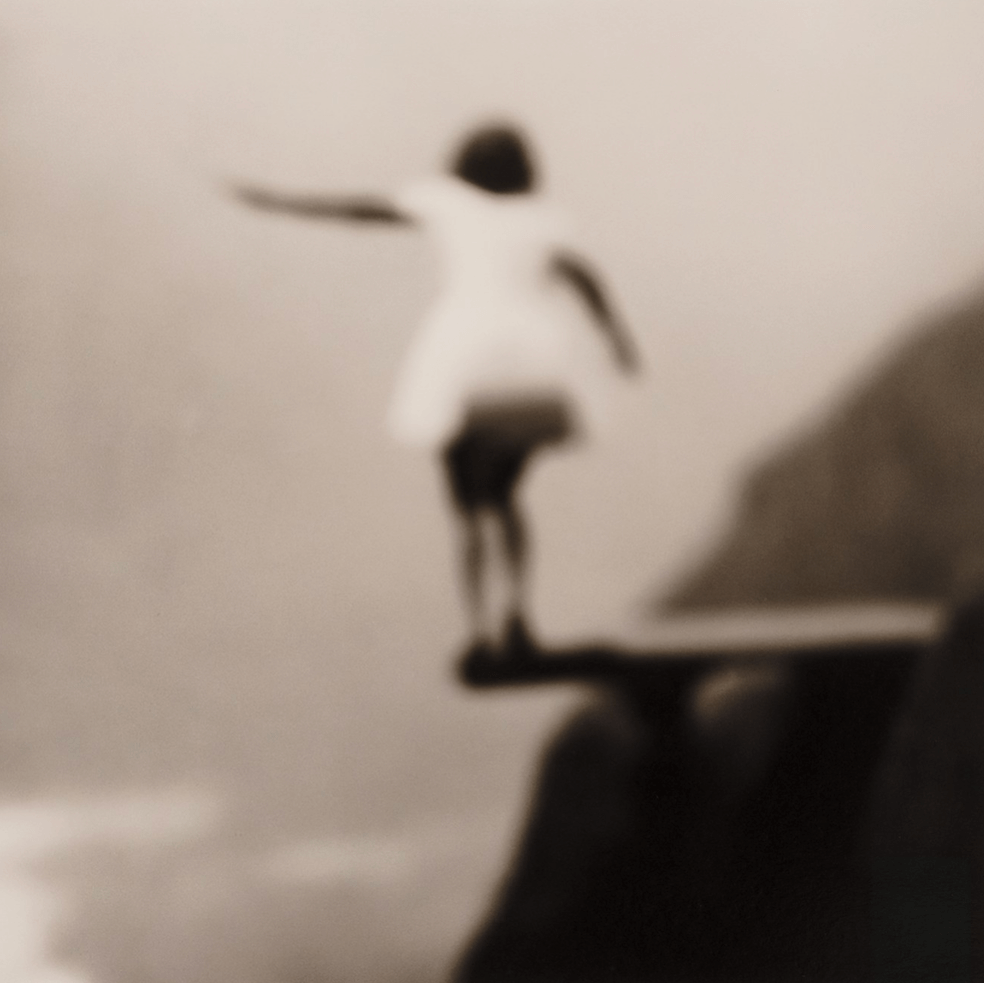In the past year, galleries have opened shows displaying AI-generated art, so it was no surprise that one of the world’s top galleries, Gagosian, would host AI art shows in New York last year and in LA this January. Bennett Miller may have been an appropriate choice—an Oscar-nominated director of the films Capote (2005), Moneyball (2011)and Foxcatcher (2014), he “directed” a series of sepia-toned prints into being, using image-generating program DALL-E 2. He claims to have used thousands of prompts to create 20 haunting surrealistic black-and-white pseudo-photographs.
Many of the blurry prints generated by Miller’s prompts are puzzling: Is that a whale on a stage? A person diving off a cliff? The ghost of a child? Miller is perhaps referencing late Victorian photography, a period when people were certain they saw apparitions floating above images of family members. Miller’s creations are eerie and even creepy, but to what end? Is he commenting on the ghost in the machine? Dialogue with OpenAI’s game-changing program, ChatGPT, is sometimes creepy and it frequently “hallucinates” responses to questions.
Miller’s works, while ambitious, left me yearning for the real thing—such as Nadar’s late-19th-century photographs or Magritte’s surrealist paintings. Even though his AI artwork didn’t convince me that image-generated work is on the level of human-made art, the stealth efforts of big tech to train their AI machines on millions of artistic images, without licensing copyrights from their creators is coming closer to producing something akin to art forgery.
In January, leaks to the media from sources close to the litigation by artists suing several tech companies for copyright infringement revealed a list of more than 16,000 names of artists whose artworks have been used to train Midjourney, an image-generating software. The artists range from the obscure to such big names as David Hockney and Damien Hirst.
In the wake of the media’s release of “The List,” stories abounded about prompts being employed by users of image-generation programs to create art “in the style of” a named artist. The prompts can be refined to specify individual works or a locale the artist depicted.
A story in The Guardian published shortly after the revelation of the list was illustrated by an AI-generated image of a Normandy pastoral in the style of Hockney, who has resided there since Covid and painted hundreds of depictions of his house and the surrounding rural vistas. Hockney’s recent Normandy works can be seen in an illustrated book, Spring Cannot Be Cancelled (2021), about his first year in the region. Despite attempts at reproducing Hockney’s bright color palette and assorted flowers and trees, it’s unlikely the AI image would be mistaken for a Hockney by those who have studied his work. However, with the rapid evolution of programming, it won’t be long before AI stymies art experts.
The biggest revelation is that programs such as Midjourney can closely approximate an artist’s style based on its training with hundreds of the artist’s works. It’s outrageous that thousands of copyrights were infringed by big tech companies without licensing or consent of the artists. The creative world is not sitting still—lawsuits against tech companies have proliferated like mushrooms.
Add The New York Times to the list of plaintiffs in suits against AI companies, such as those filed by Getty Images and the Authors Guild. The Times sued Microsoft and OpenAI for training ChatGPT with millions of Times articles, claiming the defendants now compete with the paper as a source of news and information. OpenAI, a recent start-up, is valued at $80 billion, 10 times the market cap of the Times. Yet venture capitalists and other tech bros are raising the alarm that the lawsuits have the potential to kill AI. Apparently, these tech billionaires don’t believe in the concept of intellectual property—except for their own source code.
Some art galleries clearly believe that selling art by AI prompters using programs trained on the backs of real artists is legitimate. However, there’s potential liability if galleries are profiting from selling copyright-infringing AI-generated works that closely mimic a specific artist’s pre-existing artwork. Claims against galleries could be made for infringement and fraud. There are numerous legal ramifications that should be examined before galleries go all in on the AI craze.
